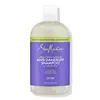What's inside
What's inside
 Key Ingredients
Key Ingredients

 Benefits
Benefits

 Concerns
Concerns

 Ingredients Side-by-side
Ingredients Side-by-side

Water
Skin ConditioningSodium Lauroyl Methyl Isethionate
CleansingCocamidopropyl Hydroxysultaine
CleansingPotassium Cocoyl Glycinate
Disodium Cocoyl Glutamate
CleansingPotassium Cocoate
EmulsifyingSodium Lauroyl Sarcosinate
CleansingGlycereth-26
HumectantDecyl Glucoside
CleansingParfum
MaskingPhenoxyethanol
PreservativeCocamidopropylamine Oxide
CleansingSodium Cocoyl Glutamate
CleansingGlycol Distearate
EmollientDisodium Laureth Sulfosuccinate
CleansingMethyl Gluceth-20
HumectantAcrylates Copolymer
PEG-120 Methyl Glucose Dioleate
EmulsifyingAmodimethicone
Polyquaternium-10
Citric Acid
BufferingEthylhexylglycerin
Skin ConditioningSodium Lauryl Sulfoacetate
CleansingDivinyldimethicone/Dimethicone Copolymer
Chlorphenesin
AntimicrobialPolyquaternium-11
Guar Hydroxypropyltrimonium Chloride
Skin ConditioningC11-15 Pareth-7
EmulsifyingTrisodium Ethylenediamine Disuccinate
Laureth-9
EmulsifyingGlycerin
HumectantTrideceth-12
EmulsifyingPanthenol
Skin ConditioningHydrolyzed Vegetable Protein Pg-Propyl Silanetriol
Skin ConditioningC12-13 Pareth-3
EmulsifyingC12-13 Pareth-23
CleansingHelianthus Annuus Seed Oil
EmollientTocopherol
AntioxidantPseudozyma Epicola/Camellia Sinensis Seed Oil Ferment Extract Filtrate
HumectantPseudozyma Epicola/Argania Spinosa Kernel Oil Ferment Filtrate
Skin ConditioningPrunus Armeniaca Kernel Oil
MaskingQuaternium-95
UV AbsorberPropanediol
SolventHelianthus Annuus Seed Extract
Skin ConditioningPEG-8
HumectantBis-Aminopropyl Diglycol Dimaleate
Skin ConditioningEuterpe Oleracea Fruit Extract
Rosmarinus Officinalis Leaf Extract
AntimicrobialPunica Granatum Extract
AstringentOriganum Vulgare Leaf Extract
Skin ConditioningMusa Sapientum Fruit Extract
Skin ConditioningMorinda Citrifolia Fruit Extract
Skin ConditioningSodium Hyaluronate
HumectantPEG-8/Smdi Copolymer
Arctium Lappa Root Extract
Skin ConditioningSodium Polyacrylate
AbsorbentPalmitoyl Myristyl Serinate
Skin ConditioningCitral
PerfumingHexyl Cinnamal
PerfumingLimonene
PerfumingBiotin
AntiseborrhoeicPentaerythrityl Tetra-Di-T-Butyl Hydroxyhydrocinnamate
AntioxidantWater, Sodium Lauroyl Methyl Isethionate, Cocamidopropyl Hydroxysultaine, Potassium Cocoyl Glycinate, Disodium Cocoyl Glutamate, Potassium Cocoate, Sodium Lauroyl Sarcosinate, Glycereth-26, Decyl Glucoside, Parfum, Phenoxyethanol, Cocamidopropylamine Oxide, Sodium Cocoyl Glutamate, Glycol Distearate, Disodium Laureth Sulfosuccinate, Methyl Gluceth-20, Acrylates Copolymer, PEG-120 Methyl Glucose Dioleate, Amodimethicone, Polyquaternium-10, Citric Acid, Ethylhexylglycerin, Sodium Lauryl Sulfoacetate, Divinyldimethicone/Dimethicone Copolymer, Chlorphenesin, Polyquaternium-11, Guar Hydroxypropyltrimonium Chloride, C11-15 Pareth-7, Trisodium Ethylenediamine Disuccinate, Laureth-9, Glycerin, Trideceth-12, Panthenol, Hydrolyzed Vegetable Protein Pg-Propyl Silanetriol, C12-13 Pareth-3, C12-13 Pareth-23, Helianthus Annuus Seed Oil, Tocopherol, Pseudozyma Epicola/Camellia Sinensis Seed Oil Ferment Extract Filtrate, Pseudozyma Epicola/Argania Spinosa Kernel Oil Ferment Filtrate, Prunus Armeniaca Kernel Oil, Quaternium-95, Propanediol, Helianthus Annuus Seed Extract, PEG-8, Bis-Aminopropyl Diglycol Dimaleate, Euterpe Oleracea Fruit Extract, Rosmarinus Officinalis Leaf Extract, Punica Granatum Extract, Origanum Vulgare Leaf Extract, Musa Sapientum Fruit Extract, Morinda Citrifolia Fruit Extract, Sodium Hyaluronate, PEG-8/Smdi Copolymer, Arctium Lappa Root Extract, Sodium Polyacrylate, Palmitoyl Myristyl Serinate, Citral, Hexyl Cinnamal, Limonene, Biotin, Pentaerythrityl Tetra-Di-T-Butyl Hydroxyhydrocinnamate
Salicylic Acid
MaskingWater
Skin ConditioningCocamidopropyl Betaine
CleansingSodium Methyl Cocoyl Taurate
CleansingSodium Chloride
MaskingGlycerin
HumectantButyrospermum Parkii Butter
Skin ConditioningAcetic Acid
BufferingRosmarinus Officinalis Extract
AntimicrobialCentella Asiatica Extract
CleansingNiacinamide
SmoothingPolyquaternium-10
Stearamidopropyl Dimethylamine
EmulsifyingGluconolactone
Skin ConditioningMenthol
MaskingCarbomer
Emulsion StabilisingSodium Hydroxide
BufferingSodium Benzoate
MaskingParfum
MaskingSalicylic Acid, Water, Cocamidopropyl Betaine, Sodium Methyl Cocoyl Taurate, Sodium Chloride, Glycerin, Butyrospermum Parkii Butter, Acetic Acid, Rosmarinus Officinalis Extract, Centella Asiatica Extract, Niacinamide, Polyquaternium-10, Stearamidopropyl Dimethylamine, Gluconolactone, Menthol, Carbomer, Sodium Hydroxide, Sodium Benzoate, Parfum
 Reviews
Reviews

Ingredients Explained
These ingredients are found in both products.
Ingredients higher up in an ingredient list are typically present in a larger amount.
Glycerin is already naturally found in your skin. It helps moisturize and protect your skin.
A study from 2016 found glycerin to be more effective as a humectant than AHAs and hyaluronic acid.
As a humectant, it helps the skin stay hydrated by pulling moisture to your skin. The low molecular weight of glycerin allows it to pull moisture into the deeper layers of your skin.
Hydrated skin improves your skin barrier; Your skin barrier helps protect against irritants and bacteria.
Glycerin has also been found to have antimicrobial and antiviral properties. Due to these properties, glycerin is often used in wound and burn treatments.
In cosmetics, glycerin is usually derived from plants such as soybean or palm. However, it can also be sourced from animals, such as tallow or animal fat.
This ingredient is organic, colorless, odorless, and non-toxic.
Glycerin is the name for this ingredient in American English. British English uses Glycerol/Glycerine.
Learn more about GlycerinParfum is a catch-all term for an ingredient or more that is used to give a scent to products.
Also called "fragrance", this ingredient can be a blend of hundreds of chemicals or plant oils. This means every product with "fragrance" or "parfum" in the ingredients list is a different mixture.
For instance, Habanolide is a proprietary trade name for a specific aroma chemical. When used as a fragrance ingredient in cosmetics, most aroma chemicals fall under the broad labeling category of “FRAGRANCE” or “PARFUM” according to EU and US regulations.
The term 'parfum' or 'fragrance' is not regulated in many countries. In many cases, it is up to the brand to define this term.
For instance, many brands choose to label themselves as "fragrance-free" because they are not using synthetic fragrances. However, their products may still contain ingredients such as essential oils that are considered a fragrance by INCI standards.
One example is Calendula flower extract. Calendula is an essential oil that still imparts a scent or 'fragrance'.
Depending on the blend, the ingredients in the mixture can cause allergies and sensitivities on the skin. Some ingredients that are known EU allergens include linalool and citronellol.
Parfum can also be used to mask or cover an unpleasant scent.
The bottom line is: not all fragrances/parfum/ingredients are created equally. If you are worried about fragrances, we recommend taking a closer look at an ingredient. And of course, we always recommend speaking with a professional.
Learn more about ParfumPolyquaternium-10 is an ammonium salt of hydroxyethylcellulose. It is a white and granular powder used as a film-former and anti-static agent.
This ingredient is commonly found in hair conditioning products. According to a manufacturer, its positive charge makes it great for absorbing hair proteins. The manufacturer also states this ingredient helps with curl retention.
For haircare friends: this ingredient is not a silicone.
Learn more about Polyquaternium-10Water. It's the most common cosmetic ingredient of all. You'll usually see it at the top of ingredient lists, meaning that it makes up the largest part of the product.
So why is it so popular? Water most often acts as a solvent - this means that it helps dissolve other ingredients into the formulation.
You'll also recognize water as that liquid we all need to stay alive. If you see this, drink a glass of water. Stay hydrated!
Learn more about Water